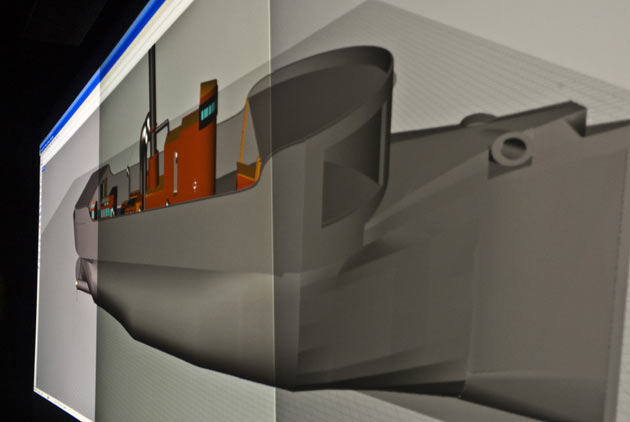Carolinians, historians, and students will soon gain a better understanding of Holocaust survivors who reside in North Carolina. Read more
RENCI, ITS Research Computing Establish Tar Heel Grid
Researchers at the University of North Carolina at Chapel Hill have a new distributed computing resource through the efforts of the Renaissance Computing Institute (RENCI) and Information Technology Services’ Research Computing. Read more
Incredible Journey
For R. Jude Samulski, viruses are the good guys.
With minimal energy and great efficiency they deliver genetic material from outside sources to the nuclei of cells. If programmed correctly, the DNA sequences they carry can change the genetic information in cells, turning diseased cells into healthy ones. Read more
Hurricane Hunter
Hurricane Awareness activities at RDU
RALEIGH, May 6, 2009—The plane on display at Raleigh-Durham International Airport’s General Aviation Terminal was a veteran of storms well known to North Carolinians: Isabel, Floyd and Fran. Read more
Stanly County teachers win RENCI Weather Web Competition
CHAPEL HILL, NC, April 29, 2009 – Stanly County will soon have detailed data about local weather conditions and new weather-related projects for school children thanks to the Renaissance Computing Institute (RENCI) Weather Web competition.
The county is the latest in the list of North Carolina counties awarded a weather station through Weather Web, which aims to enhance weather-related K-12 education and improve the quantity and quality of weather data in under served areas of the state. Read more
New website shows live local weather conditions
ASHEVILLE, NC–As a possible April snowstorm approaches, eyes are turned to the sky. Now weather buffs won’t have to look out the window to get a glimpse of regional weather, thanks to a new weather watching website created by staff and student researchers at the Renaissance Computing Institute (RENCI) at UNC Asheville. The Web site, http://www.weatherwebcams.org, gives viewers access to images from dozens of local webcams, showing nearly real time weather in more than 100 locations across North Carolina, Tennessee, Virginia and Georgia.
RENCI explores uses for 360-degree camera system
Every picture tells a story, but high-definition, 360-degree imagery can put you in a real situation, able to look around in all directions and notice the details.
RENCI’s research using a Dodeca 2360 camera system from Portland, Oregon-based Immersive Media aims to recreate real spaces in cyberspace using an 11-camera, geo-referenced imagery system that shoots high resolution video in full 360 degrees. The system collects huge amounts of data: 1 million pixels per second, or 1 gigabyte per minute. Read more
Multi-hazard risk tool aims to help Buncombe County
Emergency personnel and town planners and managers in Buncombe County have a new online tool for analyzing natural hazard risks and their potential costs.
The Buncombe County Multi-hazard Risk Tool was introduced to emergency responders and government officials from Asheville and nearby communities by Todd Pierce of RENCI at UNC Asheville at a March meeting to discuss the county’s Multi-jurisdiction Hazard Mitigation Plan. Read more
RENCI to host Open Science Grid, Cyberinfrastructure Workshop
Registration is now open for the Open Science Grid Campus and National Cyberinfrastructure Workshop, which will take place April 22-23 at the Renaissance Computing Institute (RENCI), 100 Europa Drive, Chapel Hill. A registration form is available at http://indico.fnal.gov/confRegistrationFormDisplay.py/display?confId=2504
Visualization Challenge examines history, science and more

John Wagner won the RENCI at ECU Visualization Challenge with this representation of a 19th century gunboat.
RENCI at East Carolina University’s (ECU) second annual Visualization Challenge, held March 25, featured presentations on the center’s 21-foot by 6-foot visualization wall on topics ranging from 3D archeological ship reconstruction to research into genetic diseases using fruit flies.




